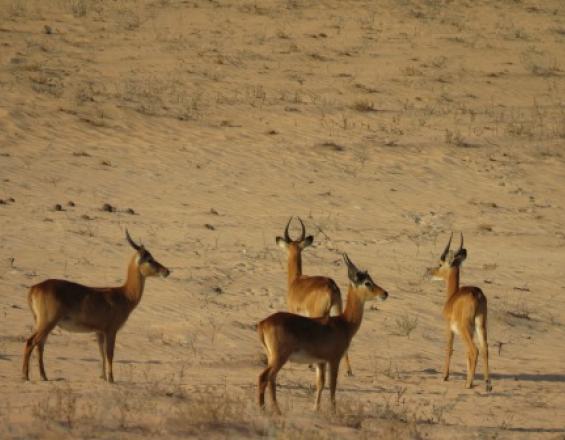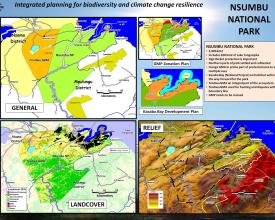
Intégration des aspects liés au changement climatique dans la planification de la gestion des zones protégées en Zambie

Le changement climatique est de plus en plus reconnu comme une menace majeure qui présentera non seulement de nouveaux risques et menaces pour les zones protégées (ZP), mais qui exacerbera également les menaces et vulnérabilités existantes. Pour de nombreuses aires protégées, les objectifs, stratégies et actions de conservation actuels devront être révisés afin de répondre au mieux aux défis posés par le changement climatique.
Malgré cela, le département des parcs nationaux et de la faune, avec le soutien technique de l'UICN, a entrepris d'intégrer les aspects liés au changement climatique dans le plan de gestion général du parc national de Nsumbu (Zambie). Cela implique la conception de mesures d'adaptation au changement climatique visant à améliorer la résilience du parc au changement climatique.
L'un des effets immédiats de cette solution est l'amélioration de la capacité des gestionnaires du parc à faire face au changement climatique et la sensibilisation accrue du public aux impacts du changement climatique sur les systèmes écologiques et sociaux. La mise en œuvre à grande échelle de la solution permettra d'améliorer la résilience des parcs au changement climatique.
Contexte
Défis à relever
Les défis à relever sont à la fois techniques et sociaux :
- Manque de reconnaissance du rôle des zones protégées dans la réalisation des objectifs d'adaptation et d'atténuation par les acteurs clés
- Accès limité aux données sur le climat et la biodiversité pour la planification de la conservation et du développement
- Capacités techniques : faible capacité technique à intégrer les considérations relatives au changement climatique dans la planification de la gestion des zones protégées.
Emplacement
Traiter
Résumé du processus
Les six éléments constitutifs sont étroitement liés.
Renforcement des capacités de résistance au changement climatique (BB1) : L'amélioration de la capacité des parties prenantes a clairement renforcé leur participation à l'évaluation de la vulnérabilité au changement climatique et de l'utilisation des terres (BB2), au développement de la stratégie sur le changement climatique (BB 3), à la révision du PGM (BB 4) et à la communication du PGM intelligent face au climat (BB 5).
(BB 4) et à la communication du PGM intelligent face au changement climatique (BB 5).
De même, les connaissances et les compétences acquises, ainsi que les informations générées lors de l'évaluation de l'utilisation des terres et de la vulnérabilité au changement climatique (BB2) sont essentielles pour le développement de la stratégie de changement climatique (BB 3) et la révision du GMP (BB 4). Le développement de la stratégie de changement climatique du parc (BB 3) et la révision du PGES (BB 4) contribuent à l'amélioration des capacités de résilience au changement climatique (BB 1) et, par conséquent, à l'amélioration des compétences en matière d'évaluation de la vulnérabilité et de l'utilisation des terres (BB 2).
La communication du plan de gestion intelligente du climat (BB 5) contribue à l'amélioration des capacités en matière de résilience climatique du parc (BB 1), d'évaluation de la vulnérabilité au changement climatique et de l'utilisation des terres (BB 2), de développement d'une stratégie de changement climatique du parc (BB 3) et de révision du plan de gestion intelligente du climat (BB 4).
Blocs de construction
Renforcement des capacités de résistance au changement climatique
L'objectif de ce bloc est de renforcer les capacités des gestionnaires de parcs en matière de changement climatique par le biais d'ateliers axés sur des sujets très spécifiques aux problèmes de changement climatique rencontrés au niveau des parcs.
Une série d'ateliers de renforcement des capacités a été organisée à Lusaka (niveau national) et à Kasama (niveau provincial/local) en 2017 pour sensibiliser aux concepts clés liés au changement climatique, y compris les impacts, la vulnérabilité et la résilience en relation avec les zones protégées. Des délégués du Département des parcs nationaux et de la faune sauvage, du Département de la gestion des ressources naturelles, de l'Administration provinciale du Nord, du Conseil du district de Nsama, du Conseil municipal de Mpulungu, du Parc national de Nsumbu, d'ONG (par exemple Conservation Lake Tanganyika - CLT et Frankfurt Zoological Society - FZS) et de programmes tels que le Projet de développement du lac Tanganyika (LTDP) ont participé à ces ateliers.
Les ateliers ont fourni aux participants des informations et des connaissances clés sur les aspects climatiques nécessaires pour les prochaines étapes de l'intégration du changement climatique dans le plan de gestion général du parc.
Facteurs favorables
- Disponibilité de parties prenantes intéressées, motivées et engagées
- Compétences efficaces en matière de communication
Leçon apprise
- Le renforcement des capacités ne doit pas être un événement ponctuel, mais plutôt une entreprise continue visant à améliorer les capacités des gestionnaires de parcs et des parties prenantes, y compris les communautés locales vivant à proximité des zones protégées.
- L'engagement et la responsabilisation accrue des communautés sont importants pour la durabilité de la solution.
- Le processus doit être accompagné d'un suivi et d'une évaluation afin de s'assurer que la sensibilisation et les capacités sont réellement améliorées.
Évaluation de la vulnérabilité au changement climatique et de l'utilisation des terres
L'objectif de ce bloc est d'évaluer la vulnérabilité de la biodiversité aux facteurs de stress climatiques et non climatiques (par exemple, les changements d'utilisation des terres). L'évaluation est une condition préalable à toute action visant à mesurer l'état de conservation de la biodiversité et la résilience au changement climatique. Ces évaluations permettent également de mieux orienter l'identification des interventions appropriées en matière d'adaptation au changement climatique.
L'évaluation de la vulnérabilité au changement climatique et de l'utilisation des terres a été réalisée en visitant le parc national de Nsumbu et les AGM adjacentes, à savoir Tondwa et Kaputwa, en interrogeant des informateurs clés et en procédant à une analyse documentaire. Alors que les visites de sites visaient à obtenir des informations cruciales par l'observation, l'étude documentaire a été menée pour compléter les informations sur le terrain. L'évaluation a été menée par des experts accompagnés de gestionnaires de parcs. Les chefs - hommes et femmes - des villages adjacents, qui ont une meilleure connaissance du parc et des zones environnantes, ont participé au processus.
Facteurs favorables
- Inventaire des connaissances traditionnelles sur la biodiversité et le changement climatique.
- Disponibilité et accès aux données scientifiques de base sur la biodiversité et le changement climatique.
- Capacité à visualiser l'état passé, présent et futur de la biodiversité dans le contexte des facteurs de stress climatiques et non climatiques.
Leçon apprise
L'examen des données existantes sur le changement climatique est essentiel pour comprendre les tendances passées et futures du changement climatique au niveau régional et national.
Les visites de sites à l'intérieur et autour du parc permettent de fournir des informations sur l'état de l'utilisation des terres et de la biodiversité/des écosystèmes sur le terrain. Plus précisément, l'observation directe fournit des informations sur les menaces et les défis auxquels est confrontée la biodiversité, ainsi que sur les signes visibles de sécheresses, d'inondations, etc. induits par le climat.
Les communautés locales, en particulier les villageois qui vivent depuis longtemps à proximité du parc national, ont une meilleure compréhension des changements locaux sur le climat et la biodiversité. Il est donc essentiel de recueillir ces informations pour valider et compléter les données mondiales et régionales et de développer une vision avec les communautés afin de concevoir des stratégies d'adaptation appropriées.
Développement d'une stratégie de lutte contre le changement climatique dans le parc
Sur la base de l'évaluation de la vulnérabilité au changement climatique et de l'utilisation des terres, des objectifs et des stratégies d'adaptation au changement climatique ont été définis afin d'améliorer la résilience du parc face au changement climatique.
Les objectifs et stratégies d'adaptation au changement climatique ont été examinés par les parties prenantes lors d'un atelier organisé à Lusaka en octobre 2017, auquel ont participé des gestionnaires de parcs du Département des parcs nationaux et de la faune, du parc national de Nsumbu et d'autres. Les contributions fournies par les parties prenantes ont été utilisées pour développer davantage les objectifs et les stratégies d'adaptation dans une stratégie de changement climatique du parc. La stratégie comprend un but, une portée et des objectifs, des stratégies d'adaptation ainsi que des plans de mise en œuvre et de suivi. Des indicateurs et des paramètres clés pour le suivi des changements dans la vulnérabilité et la résilience ont également été inclus.
Un autre atelier a été organisé en décembre 2017 à Lusaka pour valider la stratégie de changement climatique. Le ministère du Tourisme et des Arts et les ministères responsables de l'environnement et des ressources naturelles ainsi que les principaux départements et agences ont participé à l'atelier. D'autres étaient des représentants du parc national de Nsumbu, de la zone de gestion de Nsumbu-Mweru Wantipa, du projet de développement du lac Tanganyika. La stratégie finale de changement climatique du parc devait être intégrée et annexée au GMP.
Facteurs favorables
- Participation des parties prenantes ayant des connaissances sur la variabilité et le changement climatiques et sur la biodiversité
- Facilitation par un expert en changement climatique et en ressources naturelles.
- Accès à des informations actualisées sur le climat (et la biodiversité)
Leçon apprise
- La participation des parties prenantes est essentielle pour concevoir des mesures d'adaptation appropriées susceptibles d'améliorer la résilience au changement climatique. Ainsi, les parties prenantes, y compris les communautés voisines des zones protégées, devraient être impliquées dans l'identification et la validation des mesures d'adaptation et d'atténuation du changement climatique.
- L'identification des mesures d'adaptation et d'atténuation pertinentes nécessite que le processus soit facilité par un expert qualifié en matière de changement climatique ayant une bonne compréhension du contexte régional, national et local.
- La disponibilité de données de référence actualisées, tant scientifiques qu'autochtones, sur les aspects du changement climatique permet d'élaborer des mesures d'adaptation pertinentes.
Révision du plan de gestion général du parc afin d'y intégrer les aspects liés à la résilience climatique
Ce bloc aborde le travail de révision du plan de gestion afin qu'il intègre les aspects liés à la résilience au changement climatique.
Il a été convenu lors de l'atelier national de validation qui s'est tenu en décembre 2017 à Lusaka entre le Département des parcs nationaux et de la faune sauvage et le Programme de développement du lac Tanganyika (le bailleur de fonds de la révision du PGM) et d'autres parties prenantes clés que le PGM de Nsumbu sera révisé en 2018 pour inclure les aspects liés au changement climatique en rassemblant les informations de la stratégie approuvée sur le changement climatique. En outre, il a été convenu que la stratégie de changement climatique du parc sera annexée au GMP révisé.
En mars 2019, la révision du GMP est en cours et devrait être achevée vers la fin de l'année.
Facteurs favorables
Les facteurs clés de cette BB sont les suivants :
- la sensibilisation des parties prenantes aux impacts du changement climatique et aux stratégies d'adaptation pour les zones protégées
- Facilitation efficace du processus d'examen des PSG par des experts qualifiés
- la participation effective des parties prenantes au processus de révision
Leçon apprise
Pour mieux intégrer les aspects liés au changement climatique, les leçons qui se dégagent montrent qu'il est essentiel de :
- Réviser le cadre de planification de la gestion des zones protégées pour y inclure le changement climatique. Cela permettrait d'intégrer le changement climatique au cours de l'élaboration du plan de gestion des aires protégées, plutôt que dans le cadre du processus de révision.
- Réviser les menaces existantes pour la biodiversité afin d'y inclure le changement climatique.
- Réviser les objets de gestion pour intégrer la résilience au changement climatique.
Communiquer le PGM climatiquement intelligent aux parties prenantes
L'objectif de ce bloc est de sensibiliser les parties prenantes au PGM climatiquement intelligent par le biais d'une communication adaptée aux réalités de la zone du parc. Les médias à utiliser dépendent du niveau d'intervention. Par exemple, la radio communautaire et les affiches peuvent être utilisées pour éduquer les populations locales ; les plateformes en ligne sont utiles pour un large public au niveau national et international ; et les brochures sont utiles pour les visiteurs, etc.
Facteurs favorables
Des stratégies de communication appropriées qui tiennent compte des niveaux d'alphabétisation, des connaissances linguistiques et d'autres facteurs socioculturels.
Leçon apprise
Les premiers enseignements tirés sont les suivants :
- La communication sur le plan de gestion intelligente du climat permet de s'assurer que les parties prenantes sont conscientes des aspects liés au changement climatique, de susciter leur intérêt et de s'assurer de leur engagement à participer à la mise en œuvre et au respect du plan de gestion intelligente du climat en tant qu'outil de gestion du parc.
- La communication de la stratégie de changement climatique permettra aux parties prenantes de fournir un retour d'information, par le biais du suivi et de l'évaluation, sur l'efficacité de la stratégie pour atteindre les objectifs de résilience prévus.
Impacts
La solution devrait apporter des avantages sociaux et environnementaux, à court et à long terme.
Les avantages à court terme sont les suivants
- Une meilleure compréhension par les gestionnaires de parcs et le grand public des impacts du changement climatique et de la vulnérabilité de la biodiversité, des écosystèmes et des communautés adjacentes.
- Renforcement de la capacité des gestionnaires de parcs et des autres parties prenantes à concevoir et à mettre en œuvre des stratégies prioritaires d'adaptation au changement climatique et d'atténuation de ses effets.
- une reconnaissance accrue du rôle que les zones protégées peuvent jouer pour soutenir l'adaptation des écosystèmes et des communautés locales aux conditions climatiques changeantes en maintenant le flux des services écosystémiques et en atténuant les effets du changement climatique par la séquestration du carbone.
Après la mise en œuvre des mesures d'adaptation et d'atténuation, le principal impact positif à long terme attendu de la solution est la réduction de la vulnérabilité aux impacts du changement climatique, d'où une meilleure résilience au climat de la biodiversité et des écosystèmes du parc et des communautés adjacentes.
Bénéficiaires
Les bénéficiaires de cette solution sont les suivants :
- Les planificateurs et les responsables de la conservation du Département des parcs nationaux et de la faune sauvage
- Les gestionnaires du parc national de Nsumbu
- Les défenseurs de l'environnement qui travaillent dans le parc national de Nsumbu et le lac Tanganyika ou dans les environs.





